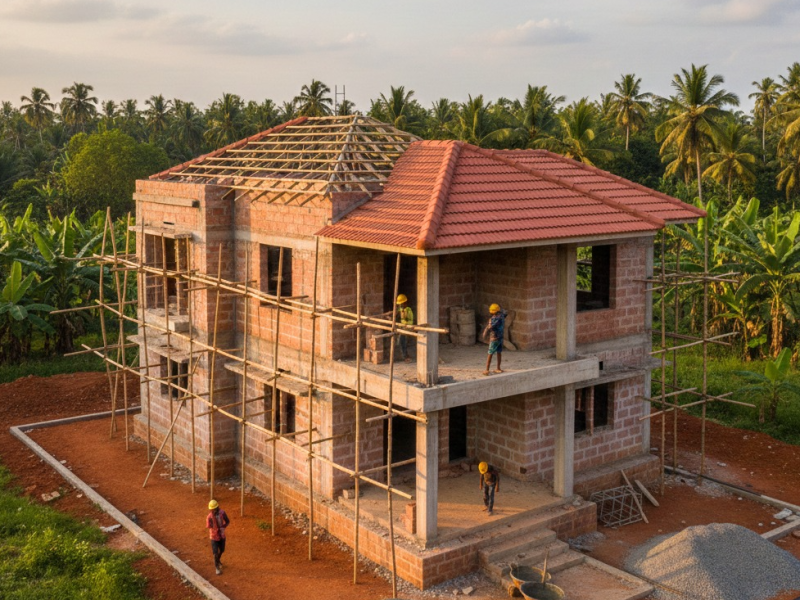Things to Check Before Buying a Plot for Home Construction in Kerala

The dream of building a home often starts with finding the
perfect piece of land—a place that resonates with your heart. While finding the
right property might feel like a stroke of luck, in today's world, luck alone
is not enough. With constantly evolving laws, zoning regulations, and
environmental guidelines, a technical understanding is just as important as
emotional appeal when it comes to choosing the right land for your dream home.
When
buying a plot, it's essential to consider that building regulations are subject
to periodic changes. Ensure the plot complies with current building regulations
before making a purchase. To build your dream home, pay attention to key
factors when buying a plot, as this will help you make an informed decision.
1. Dry Land vs. Wet Land – Know the
Legal Category of the Plot
In Kerala, land is legally classified into two primary
types: Dry Land (Purayidam) and Wet Land (Paddy/Nilam). This distinction is
critical, especially when it comes to construction permissions.
Dry Land: If your
proposed plot falls under this category, you’re free to construct without any
special restrictions.
Wet Land:
Construction is strictly regulated. As per current rules, residential
construction is limited to a maximum of 1200 sq.ft on 10 cents, and 400 sq.ft
for commercial structures.
To avoid
complications, always verify the land classification through the Revenue
Department’s online portal before making a purchase.
2. Electric Line Clearance – Distance
Matters
Before finalizing a property, it’s essential to check if any
overhead electrical lines pass through or near the land. According to Kerala
State Electricity Board (KSEB) regulations: A specific minimum distance must be
maintained between the structure and the electric line. This varies depending
on the voltage of the line. For example, an 11-kV line requires a minimum
distance of 3.7 meters vertically and 1.2 meters horizontally. Different
clearance requirements apply to 66 kV and 220 kV lines. Additionally, the home
plan must be submitted to KSEB for approval. The local Panchayat, Municipality
or Corporation will only grant construction permission after conducting a site
inspection and obtaining clearance from KSEB. Ignoring these guidelines may
lead to rejection of your building permit from the above concerned authorities.
3. Coastal Regulation Zone (CRZ)
Guidelines
If you're buying a plot near Kerala's beautiful coastal stretches,
be aware of Coastal Regulation Zone (CRZ) laws. There are rules to preserve and
protect fragile coastal ecosystems. CRZ zones are categorized into 4 such as CRZ-1,
CRZ-2, CRZ-3 & CRZ-4, based on urban/rural settings and tidal influence. Each
category has its own minimum construction distance from the high tide line.
Constructing without verifying CRZ clearance can result in legal action and
denial of building permits.
4. Zoning Regulations
Apart from the dry/wet classification, land in Kerala is
also zoned for specific purposes like Residential, Agricultural, Commercial and
Mixed Use. Only land zoned as residential is generally permitted for housing. Building
in a non-residential zone requires additional approvals and adherence to
specific setbacks and spacing requirements. In some zones, construction may be
entirely restricted. You can determine the zone by inquiring with the Panchayat,
Municipality, or Corporation, providing the survey number.
5. Railway Boundary Rules – Watch
Your Distance
Many attractive plots are located near railway lines. While
they may appear perfect on the surface, railway boundary rules must be strictly
followed.
According to Indian Railway’s regulations:
-
A minimum distance of 30 meters must be
maintained from the railway boundary.
-
If your property lies within this limit, you
must obtain a Non-Objection Certificate (NOC) from the Railway Department.
-
Failing to do so may result in legal
complications and construction halt orders.
6. Proximity to Expanding Roads
While everyone desires good road access, be cautious if the
plot is adjacent to a road undergoing widening or public works expansion. Public
roads in Kerala often have proposed width expansions. Depending on the type of
road, you may be required to maintain a certain minimum setback distance from
the road centreline. This distance varies based on National Highway, PWD road,
or Panchayat road specifications.
Ensure your construction won't fall within future road
widening plans by consulting local PWD or LSGD (Local Self Government
Department) offices before purchasing.




